
SDD Projects
Multi Channel Silicon Drift Detectors for Scintillator Readout (DRAGO)
A number of different nuclear medicine applications like breast tumor imaging, radio assisted oncological surgery, or small animal imaging requires the development of compact, high-resolution, position-sensitive γ-ray detectors.
In a new approach a single scintillator crystal is mounted on a monolithic multi channel SDD. The energy of a γ-ray photon absorbed in the scintillator is converted to a number of photons with optical wavelengths that are in turn detected by the SDD cells. Using the centroid method, the position of the γ-ray photon's interaction is reconstructed to a high precision well below 1 mm² from the individual SDD cells' signals.
In the project DRAGO (DRift detector Array based Gamma camera for Oncology) with INFN (Institutio Nationale di Fisica Nucleare) large areas of such devices are realized.
PNSensor designed a monolithic SDD array with 77 hexagonal cells and a cell size of 8.6 mm² on a 33 x 36 mm² chip resulting in 6.6 cm² active area.
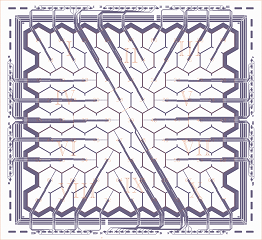
Several new technology steps have been introduced into these devices:
- The DRAGO detector is the first SDD structure that uses the poly silicon field plate technology that allows placing the bond pads apart outside of the sensitive structure.
- An antireflective coating composed of well defined silicon-oxide and silicon-nitride layers optimizes the transmittance of the SDD entrance window for the optical wavelength emitted by the scintillator.
In a precursor experiment a 3 mm thick CsI(Tl) scintillator crystal has been coupled to a 19 x 5 mm² multi cell SDD by the group of C. Fiorini of the Department of Electronics at Politecnico di Milano .
At an operating temperature of 0°C an intrinsic position resolution of 0.36 mm has been obtained by illumination through a collimator ring with a simultaneous energy resolution of 17.4 % at 122 keV and a system gain of 15.4 e-/keV.
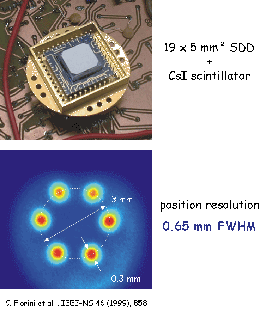
References:
Fiorini C., Longoni A., Perotti F., Labanti C., Rossi E., Lechner P., Soltau H., Strüder L.; A monolithic array of silicon drift detectors for high-resolution gamma-ray imaging; IEEE Trans. NS vol. 49(3) (2002) pp. 995-1000
Fiorini C., Longoni A., Perotti F., Labanti C., Rossi E., Lechner P., Soltau H., Strüder L.; A monolithic array of silicon drift detectors coupled to a single scintillator for γ-ray imaging with sub-millimeter position resolution; Nucl. Instr. & Meth. A 512 (2003) pp. 265-271
[up]
Ring-Shaped Silicon Drift Detectors leading to a compact XRF spectrometer (FELIX)
In 2000 a compact X-ray fluorescence (XRF) spectrometer for the investigation of art objects had been introduced.
The basic component of the system is a ring-shaped multi cell SDD with 12 hexagonal cells and a laser cut hole in its center. The sample is excited by X-rays passing through the central hole of the detector chip. The SDD ring receives the characteristic fluorescence photons emitted by the sample covering a large fraction of the solid angle around the sample. The X-rays from the source are intensified and focused by a poly capillary fiber.
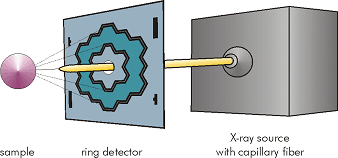
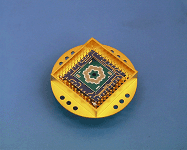
The system had been built together by the group of A. Longoni of the Department of Electronics at Politecnico di Milano. Very interesting measurements have been made by analyzing an old buckle fabricated more than 2000 years ago. A multielement picture with a spatial resolution of less than 100 µm was created.
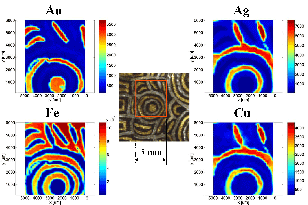
For an even more compact advanced system called FELIX worked out together with INFN (Institutio Nationale di Fisica) PNSensor combines the concept of the ring detector and the idea of the SD³ (Silicon Drift Detector Droplet) device.
The new chip design named Rococo 2 consists of 60 mm² SD³ area surounding a central hole. Compared to the previous 12 element SDD it reduces the number of readout channels and offers an improved area fill factor.
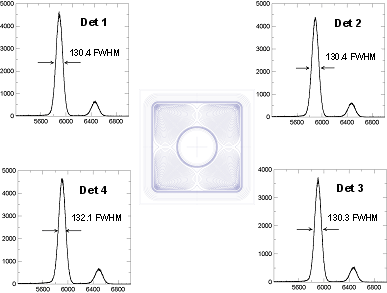
Reference:
Longoni A., Fiorini C., Guazzoni C., Gianoncelli A., Strüder L., Soltau H., Lechner P., Bjeoumikhov A., Schmalz J., Langhoff N., Wedell R.; A new XRF spectrometer based on a ring-shaped multi-element silicon drift detector and on X-ray capillary optics; IEEE Trans. NS vol.49(3) (2002) pp.1001-1005
[up]
Large Silicon Drift Detector Arrays to be used in Medium Energy Physics (SIDDHARTA)
A new large SDD with a size of 1 cm² has been developed.
It has been assembled to 3 x 1 cm² fields for the project SIDDHARTA (SIlicon Drift Detector for Hadronic Atom Research by Timing Application) with INFN (Institutio Nationale di Fisica Nucleare).
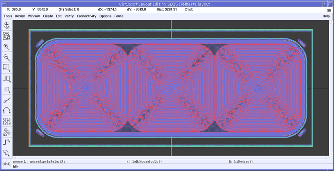
At the Italian National Laboratory at Frascati an array of totally 200 SDDs will detect soft X-rays emitted by kaonic atoms. I.e. atoms composed of nucleons and kaons instead of electrons. Due to their large mass kaons have a high probability to be localized within the nucleus. Their energetic states are therefore dominated by the effects of strong interaction.
Hence the SIDDHARTA experiment will allow to determine the relevant yet unknown parameters of strong interaction experimentally.
SIDDHARTA will profit from the SDD's simultaneous excellent spectroscopic resolution and count rate capability. The fast readout of the SDD in combination with triggered operation will help to detect rare events in the high background environment at the Frascati accelerator facility DANE.
[up]
Fast Timing X-ray Astronomy with Silicon Drift Detectors (XTRA)
The next generation X-ray satellite XEUS (X-ray Evolving Universe Spectroscopy mission) of the European Space Agency (ESA) will investigate objects at extreme distances, i.e. objects of the young universe. Early black holes, early galaxies and their formation to clusters, as well as the evolution of chemical element synthesis will be analyzed.
Moreover the telescope's large aperture, will be used to collect X-rays from time-variable objects with a periodicity in the msec range. These so-called quasi-periodic oscillations in the X-ray emission are generated in the inner accretion flows around the most extreme compact massive objects, black holes and neutron stars, and carry information about regions of strongly curved space-time. This is a regime in which important predictions of the theory of general relativity are to be tested.
To perform timing studies an instrument named XTRA (XEUS Timing for Relativistic Astronomy) will be integrated in the XEUS focal plane. As the time-variable objects are among the brightest sources in the X-ray sky the requirements for the detection system are extreme: count rates up to 10 million photons per sec with a timing resolution of 10 µsec have to be handled. Simultaneously, the energy resolution should be in the order of 200 eV (FWHM at 6 keV) to exploit the spectroscopic effects of strong gravity, e.g. relativistic line broadening.
To meet the specifications Silicon Drift Detectors and readout electronics are developed and investigated in a collaboration of PNSensor, the Max-Planck-Institute for Extraterrestrial Physics (Garching/Germany) and the Centre d'Etudes Spatiale des Rayonnements (Toulouse/France).
It is foreseen to distribute the enormous flux of X-ray photons over 10 or more cells of a multi cell SDD by operating the detector out of the focal plane. The following figure shows one possible layout of a multi cell SDD for XTRA composed of 19 cells with a sensitive area of 5 mm² per cell. The count rate capability of one single SDD cell is demonstrated below.
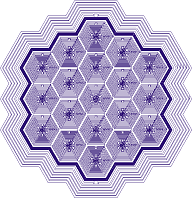 19 element SDD
19 element SDD
Count Rate Dependence of X-Flash System 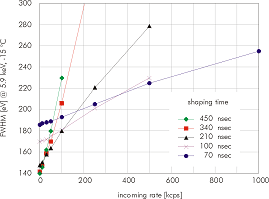
The SDD in combination with the special high-rate XFlash readout electronics developed by the Berlin company RÖNTEC is able to digest up to 1 million incoming photons per sec with an energy resolution of 250 eV (FWHM at 6 keV).
References:
Strüder L., Barret D., Fiorini C., Kendziorra E., Lechner P.; Fast Timing on XEUS; Proc. SPIE 5165 (2004) pp. 19-25
Staubert R., Kendziorra E., Barret D., Skinner G.K., Lechner P., Strüder L., van der Klis M., Stella L., Miller M.C.; Proposal to do fast X-ray timing with XEUS; Proc. SPIE 4851 (2003), pp. 414-420
[up]

